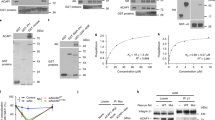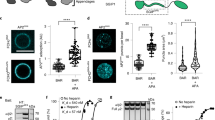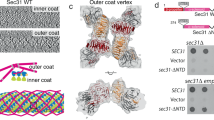Abstract
COPI (coat protein I) and the clathrin–AP-2 (adaptor protein 2) complex are well-characterized coat proteins, but a component that is common to these two coats has not been identified. The GTPase-activating protein (GAP) for ADP-ribosylation factor 1 (ARF1), ARFGAP1, is a known component of the COPI complex. Here, we show that distinct regions of ARFGAP1 interact with AP-2 and coatomer (components of the COPI complex). Selectively disrupting the interaction of ARFGAP1 with either of these two coat proteins leads to selective inhibition in the corresponding transport pathway. The role of ARFGAP1 in AP-2-regulated endocytosis has mechanistic parallels with its roles in COPI transport, as both its GAP activity and coat function contribute to promoting AP-2 transport.
This is a preview of subscription content, access via your institution
Access options
Subscribe to this journal
Receive 12 print issues and online access
$209.00 per year
only $17.42 per issue
Buy this article
- Purchase on Springer Link
- Instant access to full article PDF
Prices may be subject to local taxes which are calculated during checkout








Similar content being viewed by others
References
Bonifacino, J. S. & Glick, B. S. The mechanisms of vesicle budding and fusion. Cell 116, 153–166 (2004).
Cai, H., Reinisch, K. & Ferro-Novick, S. Coats, tethers, Rabs, and SNAREs work together to mediate the intracellular destination of a transport vesicle. Dev. Cell 12, 671–682 (2007).
Lee, M. C., Miller, E. A., Goldberg, J., Orci, L. & Schekman, R. Bi-directional protein transport between the ER and Golgi. Annu. Rev. Cell Dev. Biol. 20, 87–123 (2004).
McMahon, H. T. & Mills, I. G. COP and clathrin-coated vesicle budding: different pathways, common approaches. Curr. Opin. Cell Biol. 16, 379–391 (2004).
Pucadyil, T. J. & Schmid, S. L. Conserved functions of membrane active GTPases in coated vesicle formation. Science 325, 1217–1220 (2009).
Hsu, V. W., Lee, S. Y. & Yang, J. S. The evolving understanding of COPI vesicle formation. Nat. Rev. Mol. Cell Biol. 10, 360–364 (2009).
Waters, M. G., Serafini, T. & Rothman, J. E. ‘Coatomer’: a cytosolic protein complex containing subunits of non-clathrin-coated Golgi transport vesicles. Nature 349, 248–251 (1991).
Barlowe, C. et al. COPII: a membrane coat formed by Sec proteins that drive vesicle budding from the endoplasmic reticulum. Cell 77, 895–907 (1994).
Pearse, B. M. F. Coated vesicles from pig brain: purification and biochemical characterization. J. Mol. Biol. 97, 93–98 (1975).
Pearse, B.M. & Robinson, M. S. Purification and properties of 100-kd proteins from coated vesicles and their reconstitution with clathrin. EMBO J. 3, 1951–1957 (1984).
Maldonado-Baez, L. & Wendland, B. Endocytic adaptors: recruiters, coordinators and regulators. Trends Cell Biol. 16, 505–513 (2006).
Ungewickell, E. J. & Hinrichsen, L. Endocytosis: clathrin-mediated membrane budding. Curr. Opin. Cell Biol. 19, 417–425 (2007).
Traub, L. M. Tickets to ride: selecting cargo for clathrin-regulated internalization. Nat. Rev. Mol. Cell Biol. 10, 583–596 (2009).
Hsu, V. W. & Yang, J. S. Mechanisms of COPI vesicle formation. FEBS Lett 583, 3758–3763 (2009).
Miller, E. A. & Barlowe, C. Regulation of coat assembly–sorting things out at the ER. Curr. Opin. Cell Biol. 22, 447–453 (2010).
D’Souza-Schorey, C. & Chavrier, P. ARF proteins: roles in membrane traffic and beyond. Nat. Rev. Mol. Cell Biol. 7, 347–358 (2006).
Casanova, J. E. Regulation of Arf activation: the Sec7 family of guanine nucleotide exchange factors. Traffic 8, 1476–1485 (2007).
Inoue, H. & Randazzo, P. A. Arf GAPs and their interacting proteins. Traffic 8, 1465–1475 (2007).
Yang, J. S. et al. ARFGAP1 promotes the formation of COPI vesicles, suggesting function as a component of the coat. J. Cell Biol. 159, 69–78 (2002).
Lee, S. Y., Yang, J. S., Hong, W., Premont, R. T. & Hsu, V. W. ARFGAP1 plays a central role in coupling COPI cargo sorting with vesicle formation. J. Cell Biol. 168, 281–290 (2005).
Schmid, E. M. et al. Role of the AP2 β-appendage hub in recruiting partners for clathrin-coated vesicle assembly. PLoS Biol. 4, 1532–1548 (2006).
Rawet, M., Levi-Tal, S., Szafer-Glusman, E., Parnis, A. & Cassel, D. ArfGAP1 interacts with coat proteins through tryptophan-based motifs. Biochem. Biophys. Res. Commun. 394, 553–557 (2010).
Motley, A., Bright, N. A., Seaman, M. N. & Robinson, M. S. Clathrin-mediated endocytosis in AP-2-depleted cells. J. Cell Biol. 162, 909–918 (2003).
Saitoh, A., Shin, H. W., Yamada, A., Waguri, S. & Nakyryama, K. Three homologous ArfGAPs participate in coat protein I-mediated transport. J. Biol. Chem. 284, 13948–13957 (2009).
Mishra, S. K. et al. Dual engagement regulation of protein interactions with the AP-2 adaptor α appendage. J. Biol. Chem. 279, 46191–46203 (2004).
Praefcke, G. J. et al. Evolving nature of the AP2 α-appendage hub during clathrin-coated vesicle endocytosis. EMBO J. 23, 4371–4383 (2004).
Cole, N. B., Ellenberg, J., Song, J., DiEuliis, D. & Lippincott-Schwartz, J. Retrograde transport of Golgi-localized proteins to the ER. J. Cell Biol. 140, 1–15 (1998).
Yang, J. S. et al. A role for BARS at the fission step of COPI vesicle formation from Golgi membrane. EMBO J. 24, 4133–4143 (2005).
Yang, J. S. et al. A role for phosphatidic acid in COPI vesicle fission yields insights into Golgi maintenance. Nat. Cell Biol. 10, 1146–1153 (2008).
Conner, S. D. & Schmid, S. L. Regulated portals of entry into the cell. Nature 422, 37–44 (2003).
Presley, J. F. et al. ER-to-Golgi transport visualized in living cells. Nature 389, 81–85 (1997).
Bonazzi, M. et al. CtBP3/BARS drives membrane fission in dynamin-independent transport pathways. Nat. Cell Biol. 7, 570–580 (2005).
Guo, Q., Vasile, E. & Krieger, M. Disruptions in Golgi structure and membrane traffic in a conditional lethal mammalian cell mutant are corrected by ε-COP. J. Cell Biol. 125, 1213–1224 (1994).
Dascher, C. & Balch, W. E. Dominant inhibitory mutants of ARF1 block endoplasmic reticulum to Golgi transport and trigger disassembly of the Golgi apparatus. J. Biol. Chem. 269, 1437–1448 (1994).
Weixel, K. M. & Bradbury, N. A. Mu 2 binding directs the cystic fibrosis transmembrane conductance regulator to the clathrin-mediated endocytic pathway. J. Biol. Chem. 276, 46251–46259 (2001).
Ehrlich, M. et al. Endocytosis by random initiation and stabilization of clathrin-coated pits. Cell 118, 591–605 (2004).
Loerke, D. et al. Cargo and dynamin regulate clathrin-coated pit maturation. PLoS Biol. 7, 628–639 (2009).
Mettlen, M., Loerke, D., Yarar, D., Danuser, G. & Schmid, S. L. Cargo- and adaptor-specific mechanisms regulate clathrin-mediated endocytosis. J. Cell Biol. 188, 919–933 (2010).
Boucrot, E., Saffarian, S., Zhang, R. & Kirchhausen, T. Roles of AP-2 in clathrin-mediated endocytosis. PloS ONE 5, e10597 (2010).
Collawn, J. F. et al. Transferrin receptor internalization sequence YXRF implicates a tight turn as the structural recognition motif for endocytosis. Cell 63, 1061–1072 (1990).
McGraw, T. E., Pytowski, B., Arzt, J. & Ferrone, C. Mutagenesis of the human transferrin receptor: two cytoplasmic phenylalanines are required for efficient internalization and a second-site mutation is capable of reverting an internalization-defective phenotype. J. Cell Biol. 112, 853–861 (1991).
Alvarez, E., Girones, N. & Davis, R. J. Intermolecular disulfide bonds are not required for the expression of the dimeric state and functional activity of the transferrin receptor. EMBO J. 8, 2231–2240 (1989).
Szafer, E. et al. Role of coatomer and phospholipids in GTPase-activating protein-dependent hydrolysis of GTP by ADP-ribosylation factor-1. J. Biol. Chem. 275, 23615–23619 (2000).
Krauss, M. et al. ARF6 stimulates clathrin/AP-2 recruitment to synaptic membranes by activating phosphatidylinositol phosphate kinase type Iγ. J. Cell Biol. 162, 113–124 (2003).
Palacios, F., Schweitzer, J. K., Boshans, R. L. & D’Souza-Schorey, C. ARF6-GTP recruits Nm23-H1 to facilitate dynamin-mediated endocytosis during adherens junctions disassembly. Nat. Cell Biol. 4, 929–936 (2002).
Paleotti, O. et al. The small G-protein Arf6GTP recruits the AP-2 adaptor complex to membranes. J. Biol. Chem. 280, 21661–21666 (2005).
Goldberg, J. Decoding of sorting signals by coatomer through a GTPase switch in the COPI coat complex. Cell 100, 671–679 (2000).
Jackson, L. P. et al. A large-scale conformational change couples membrane recruitment to cargo binding in the AP2 clathrin adaptor complex. Cell 141, 1220–1229 (2010).
Rapoport, I. et al. Regulatory interactions in the recognition of endocytic sorting signals by AP-2 complexes. EMBO J. 16, 2240–2250 (1997).
Honda, A. et al. Phosphatidylinositol 4-phosphate 5-kinase α is a downstream effector of the small G protein ARF6 in membrane ruffle formation. Cell 99, 521–532 (1999).
Lanoix, J. et al. GTP hydrolysis by arf-1 mediates sorting and concentration of Golgi resident enzymes into functional COP I vesicles. EMBO J. 18, 4935–4948 (1999).
Matsui, W. & Kirchhausen, T. Stabilization of clathrin coats by the core of the clathrin-associated protein complex AP-2. Biochemistry 29, 10791–10798 (1990).
Li, J. et al. An ACAP1-containing clathrin coat complex for endocytic recycling. J. Cell Biol. 178, 453–464 (2007).
Dai, J. et al. ACAP1 promotes endocytic recycling by recognizing recycling sorting signals. Dev. Cell 7, 771–776 (2004).
Trucco, A. et al. Secretory traffic triggers the formation of tubular continuities across Golgi sub-compartments. Nat. Cell Biol. 6, 1071–1081 (2004).
Peter, K. et al. Ablation of internalization signals in the carboxyl-terminal tail of the cystic fibrosis transmembrane conductance regulator enhances cell surface expression. J. Biol. Chem. 277, 49952–49957 (2002).
Che, M. M., Nie, Z. & Randazzo, P. A. Assays and properties of the Arf GAPs AGAP1, ASAP1, and Arf GAP1. Methods Enzymol. 404, 147–163 (2005).
Saffarian, S. & Kirchhausen, T. Differential evanescence nanometry: live-cell fluorescence measurements with 10-nm axial resolution on the plasma membrane. Biophys. J. 94, 2333–2342 (2008).
Acknowledgements
We thank B. Wendland for critical comments. This work was financially supported by grants from the National Institutes of Health to V.W.H. (GM058615 and GM073016), T.K. (GM075252 and U54 AI057159—NERCE Imaging Resource) and J.F.C. (DK060065). A.L. was financially supported by the Telethon (Italy) and AIRC (Italy). H.G. was supported by a Marie Curie Fellowship. E.C. was supported by a GlaxoSmithKline fellowship.
Author information
Authors and Affiliations
Contributions
M.B., H.G., G.T., E.C., J-S.Y., J.L., G.V.B., Z.N., L.F. and R.L. carried out experiments and data analyses. V.W.H., A.L., T.K. and J.F.C. supervised the work. V.W.H., A.L., H.G. and M.B. wrote the manuscript.
Corresponding author
Ethics declarations
Competing interests
The authors declare no competing financial interests.
Supplementary information
Supplementary Information
Supplementary Information (PDF 1120 kb)
Rights and permissions
About this article
Cite this article
Bai, M., Gad, H., Turacchio, G. et al. ARFGAP1 promotes AP-2-dependent endocytosis. Nat Cell Biol 13, 559–567 (2011). https://doi.org/10.1038/ncb2221
Received:
Accepted:
Published:
Issue Date:
DOI: https://doi.org/10.1038/ncb2221
This article is cited by
-
The late stage of COPI vesicle fission requires shorter forms of phosphatidic acid and diacylglycerol
Nature Communications (2019)
-
ALDH7A1 inhibits the intracellular transport pathways during hypoxia and starvation to promote cellular energy homeostasis
Nature Communications (2019)
-
GAPDH inhibits intracellular pathways during starvation for cellular energy homeostasis
Nature (2018)
-
Ror2 signaling regulates Golgi structure and transport through IFT20 for tumor invasiveness
Scientific Reports (2017)
-
A role for retromer in hepatitis C virus replication
Cellular and Molecular Life Sciences (2016)



